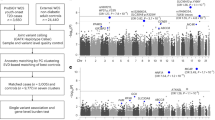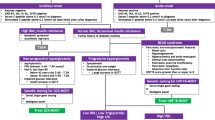Abstract
Purpose of Review
To provide an update on knowledge the role of genetics in youth-onset type 2 diabetes (T2D).
Recent Findings
The prevalence in youth of T2D, once thought to be exclusively a disease of adults, has increased by over 35% since 2001. Youth with T2D tend to have higher rates of complications, more aggressive disease, with more rapid loss of beta-cell function and a less favorable response to treatment than adults. Obesity is the most important risk factor for T2D, and the rise in childhood overweight and obesity appears responsible for the dramatic increase in T2D in youth. However, some obese children do not develop T2D, consistent with genetic differences in susceptibility to the disease in the setting of obesity and insulin resistance, currently far less well characterized in youth than in adults. Recent studies have begun to show associations of several established adult T2D genetic risk variants with youth-onset T2D and related glycemic quantitative traits, including the strongest known cross-population T2D genetic contributor TCF7L2. Maturity-onset diabetes of the young (MODY), a diabetes subtype distinct from type 1 diabetes (T1D) and T2D, is now known to result from a highly penetrant gene mutation in one of several genes. MODY has been shown to account for or contribute to at least 4.5% of clinically diagnosed T2D, even among those who are overweight or obese, impacting treatment decisions. The recently formed ProDiGY (Progress in Diabetes Genetics in Youth) Consortium is using genome-wide association studies and whole exome sequencing to understand the genetic architecture of T2D in youth, including how it differs from that of adults.
Summary
The limited amount of research conducted to date on the genetics of youth-onset T2D, which tends to be a more aggressive disease than adult T2D, suggests some overlap with genes involved in adult T2D and a sizeable influence of highly penetrant monogenic diabetes variants. The ProDiGY Consortium is expected to provide a more comprehensive understanding of youth T2D genetics.
Similar content being viewed by others
References
Papers of particular interest, published recently, have been highlighted as: • Of importance •• Of major importance
Dabelea D, Mayer-Davis EJ, Saydah S, Imperatore G, Linder B, Divers J, et al. Prevalence of type 1 and type 2 diabetes among children and adolescents from 2001 to 2009. JAMA. 2014;311(17):1778–86. https://doi.org/10.1001/jama.2014.3201.
Pinhas-Hamiel O, Zeitler P. The global spread of type 2 diabetes mellitus in children and adolescents. J Pediatr. 2005;146(5):693–700.
Urakami T, Kubota S, Nitadori Y, Harada K, Owada M, Kitagawa T. Annual incidence and clinical characteristics of type 2 diabetes in children as detected by urine glucose screening in the Tokyo metropolitan area. Diabetes Care. 2005;28(8):1876–81.
Harron KL, Feltbower RG, McKinney PA, Bodansky HJ, Campbell FM, Parslow RC. Rising rates of all types of diabetes in south Asian and non-south Asian children and young people aged 0-29 years in West Yorkshire, U.K., 1991-2006. Diabetes Care. 2011;34(3):652–4. https://doi.org/10.2337/dc10-1512.
Praveen PA, Kumar SR, Tandon N. Type 2 diabetes in youth in South Asia. Curr Diab Rep. 2015;15(2):571. https://doi.org/10.1007/s11892-014-0571-4.
Lee JM. Why young adults hold the key to assessing the obesity epidemic in children. Arch Pediatr Adolesc Med. 2008;162(7):682–7. https://doi.org/10.1001/archpedi.162.7.682.
TODAY Study Group. Retinopathy in youth with type 2 diabetes participating in the TODAY clinical trial. Diabetes Care. 2013;36(6):1772–4. https://doi.org/10.2337/dc12-2387.
Mayer-Davis EJ, Davis C, Saadine J, et al. Diabetic retinopathy in the SEARCH for Diabetes in Youth Cohort: a pilot study. Diabet Med. 2012;29(9):1148–52. https://doi.org/10.1111/j.1464-5491.2012.03591.x.
Maahs DM, Snively BM, Bell RA, Dolan L, Hirsch I, Imperatore G, et al. Higher prevalence of elevated albumin excretion in youth with type 2 than type 1 diabetes: the SEARCH for Diabetes in Youth study. Diabetes Care. 2007;30(10):2593–8.
Nadeau KJ, Anderson BJ, Berg EG, et al. Youth-onset type 2 diabetes consensus report: current status, challenges, and priorities. Diabetes Care. 2016;39(9):1635–42. https://doi.org/10.2337/dc16-1066.
Narasimhan S, Weinstock RS. Youth-onset type 2 diabetes mellitus: lessons learned from the TODAY study. Mayo Clin Proc. 2014;89(6):806–16. https://doi.org/10.1016/j.mayocp.2014.01.009.
Constantino MI, Molyneaux L, Limacher-Gisler F, et al. Long-term complications and mortality in young-onset diabetes: type 2 diabetes is more hazardous and lethal than type 1 diabetes. Diabetes Care. 2013;36(12):3863–9. https://doi.org/10.2337/dc12-2455.
TODAY Study Group, Zeitler P, Hirst K, et al. A clinical trial to maintain glycemic control in youth with type 2 diabetes. N Engl J Med. 2012;366(24):2247–56. https://doi.org/10.1056/NEJMoa1109333.
Barnett AH, Eff C, Leslie RD, Pyke DA. Diabetes in identical twins. A study of 200 pairs. Diabetologia. 1981;20:87–93.
•• Willemsen G, Ward KJ, Bell CG, et al. The concordance and heritability of type 2 diabetes in 34,166 twin pairs from international twin registers: the Discordant Twin (DISCOTWIN) Consortium. Twin Res Hum Genet. 2015;18(6):762–71. https://doi.org/10.1017/thg.2015.83. This paper describes an updated description of a large multi-center twin study of youth-onset type 2 diabetes, which provides current opportunities to update concordance and heritability estimates and a resource for future large-scale genomics and other –omics studies.
Fuchsberger C, Flannick J, Teslovich TM, Mahajan A, Agarwala V, Gaulton KJ, et al. The genetic architecture of type 2 diabetes. Nature. 2016;536(7614):41–7.
Dupuis J, Langenberg C, Prokopenko I, et al. New genetic loci implicated in fasting glucose homeostasis and their impact on type 2 diabetes risk. Nat Genet. 2010;42(2):105–16.
Kelliny C, Ekelund U, Andersen LB, et al. Common genetic determinants of glucose homeostasis in healthy children: the European Youth Heart Study. Diabetes. 2009;58(12):2939–45. https://doi.org/10.2337/db09-0374.
Barker A, Sharp SJ, Timpson NJ, et al. Association of genetic Loci with glucose levels in childhood and adolescence: a meta-analysis of over 6,000 children. Diabetes. 2011;60(6):1805–12. https://doi.org/10.2337/db10-1575.
Giannini C, Dalla Man C, Groop L, et al. Co-occurrence of risk alleles in or near genes modulating insulin secretion predisposes obese youth to prediabetes. Diabetes Care. 2014;37(2):475–82. https://doi.org/10.2337/dc13-1458.
Dabelea D, Dolan LM, D’Agostino R Jr, et al. Association testing of TCF7L2 polymorphisms with type 2 diabetes in multi-ethnic youth. Diabetologia. 2011;54(3):535–9. https://doi.org/10.1007/s00125-010-1982-7.
Tattersall R. Maturity-onset diabetes of the young: a clinical history. Diabet Med. 1998;15(1):11–4. https://doi.org/10.1002/(SICI)1096-9136(199801)15:1<11::AID-DIA561>3.0.CO;2-0.
Fajans SS, Conn JW. Tolbutamide-induced improvement in carbohydrate tolerance of young people with mild diabetes mellitus. Diabetes. 1960;9:83–8.
Fajans SS, Bell GI. MODY: history, genetics, pathophysiology, and clinical decision making. Diabetes Care. 2011;34(8):1878–84. https://doi.org/10.2337/dc11-0035.
Tattersall RB. Mild familial diabetes with dominant inheritance. Q J Med. 1974;43(170):339–57.
Tattersall RB, Fajans SS. A difference between the inheritance of classical juvenile-onset and maturity-onset type diabetes of young people. Diabetes. 1975;24(1):44–53.
Fajans SS, Floyd JC, Tattersall RB, Williamson JR, Pek S, Taylor CI. The various faces of diabetes in the young: changing concepts. Arch Intern Med. 1976;136(2):194–202.
Froguel P, Zouali H, Vionnet N, Velho G, Vaxillaire M, Sun F, et al. Familial hyperglycemia due to mutations in glucokinase. Definition of a subtype of diabetes mellitus. N Engl J Med. 1993;328(10):697–702.
Yamagata K, Oda N, Kaisaki PJ, Menzel S, Furuta H, Vaxillaire M, et al. Mutations in the hepatocyte nuclear factor-1alpha gene in maturity-onset diabetes of the young (MODY3). Nature. 1996;384(6608):455–8.
Yamagata K, Furuta H, Oda N, Kaisaki PJ, Menzel S, Cox NJ, et al. Mutations in the hepatocyte nuclear factor-4alpha gene in maturity-onset diabetes of the young (MODY1). Nature. 1996;384(6608):458–60.
Horikawa Y, Iwasaki N, Hara M, Furuta H, Hinokio Y, Cockburn BN, et al. Mutation in hepatocyte nuclear factor-1 beta gene (TCF2) associated with MODY. Nat Genet. 1997;17(4):384–5.
• Kleinberger JW, Pollin TI. Undiagnosed MODY: time for action. Curr Diab Rep. 2015;15(12):110. https://doi.org/10.1007/s11892-015-0681-7. This paper describes the prevalence of known monogenic causes of diabetes in a clinical trial cohort of youth clinically diagnosed with type 2 diabetes and treatment implications of not including MODY on the differential.
Ehtisham S, Hattersley AT, Dunger DB, Barrett TG. First UK survey of paediatric type 2 diabetes and MODY. Arch Dis Child. 2004;89(6):526–9.
Pihoker C, Gilliam LK, Ellard S, Dabelea D, Davis C, Dolan LM, et al. Prevalence, characteristics and clinical diagnosis of maturity onset diabetes of the young due to mutations in HNF1A, HNF4A, and glucokinase: results from the SEARCH for Diabetes in Youth. J Clin Endocrinol Metab. 2013;98(10):4055–62.
Rubio-Cabezas O, Hattersley AT, Njolstad PR, et al. ISPAD Clinical Practice Consensus Guidelines 2014. The diagnosis and management of monogenic diabetes in children and adolescents. Pediatr Diabetes. 2014;15(Suppl 20):47–64. https://doi.org/10.1111/pedi.12192.
Richards S, Aziz N, Bale S, et al. Standards and guidelines for the interpretation of sequence variants: a joint consensus recommendation of the American College of Medical Genetics and Genomics and the Association for Molecular Pathology. Genet Med. 2015;17(5):405–24. https://doi.org/10.1038/gim.2015.30.
Patel KA, Oram RA, Flanagan SE, et al. Type 1 Diabetes Genetic Risk Score: a novel tool to discriminate monogenic and type 1 diabetes. Diabetes. 2016;65(7):2094–9. https://doi.org/10.2337/db15-1690.
Flannick J, Thorleifsson G, Beer NL, et al. Loss-of-function mutations in SLC30A8 protect against type 2 diabetes. Nat Genet. 2014;46(4):357–63. https://doi.org/10.1038/ng.2915.
Acknowledgments
Toni I. Pollin has received grant funding from NIH (U01 DK061230) supporting her contribution to this work. Jennifer Todd has received grant funding from NIH (5K12DK094721-07) supporting her contribution to this work.
Author information
Authors and Affiliations
Corresponding author
Ethics declarations
Conflict of Interest
Jennifer N. Todd, Shylaja Srinivasan, and Toni I. Pollin declare that they have no conflict of interest.
Human and Animal Rights and Informed Consent
This article does not contain any studies with animal subjects performed by any of the authors. All procedures reported that were performed in studies involving human participants were in accordance with the ethical standards of the institutional and/or national research committee and with the 1964 Helsinki Declaration and its later amendments or comparable ethical standards.
Additional information
This article is part of the Topical Collection on Pediatric Type 2 and Monogenic Diabetes
Rights and permissions
About this article
Cite this article
Todd, J.N., Srinivasan, S. & Pollin, T.I. Advances in the Genetics of Youth-Onset Type 2 Diabetes. Curr Diab Rep 18, 57 (2018). https://doi.org/10.1007/s11892-018-1025-1
Published:
DOI: https://doi.org/10.1007/s11892-018-1025-1




